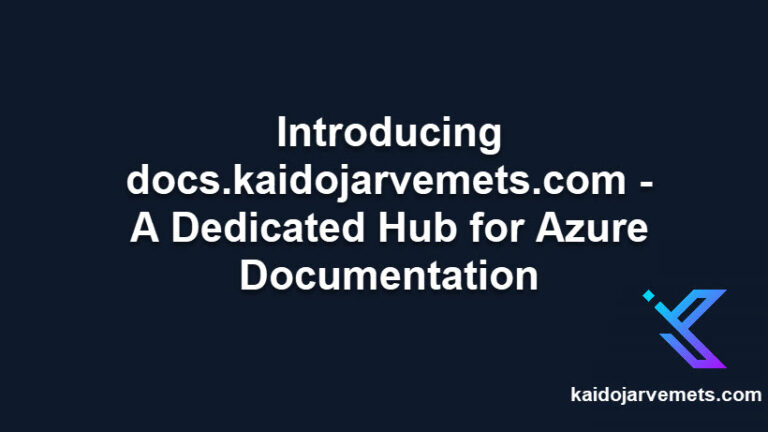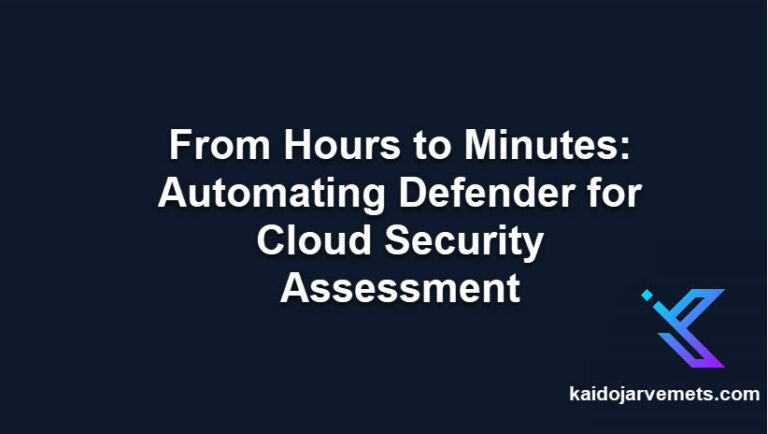Why “Temporary” Azure Setups Become Permanent Nightmares
Every Azure team says the same thing.
- “We’ll just put everything in one subscription for now.”
- “We’ll organize it properly later.”
- “This is just TEMPORARY.”
You’ve said it. Your team has said it. We all believed it.
LATER never comes.
That TEMPORARY setup from 3 years ago? It’s now running production services. Revenue depends on it. Customers rely on it. And nobody dares touch it.
As a Microsoft MVP for 15 years, I’ve become Azure’s architectural fortune teller. I can show you exactly how today’s QUICK FIXES become tomorrow’s technical nightmares. The pattern never changes.
The Birth of an Architectural Prison
It starts innocently enough. You need to deploy quickly. The business is pushing. “Just get something working,” they say.
So you do what makes sense at the time:
- Dump everything into one subscription
- Use default networking
- Create ad-hoc resource groups
- Grant permissions as needed
- Promise to “organize it properly later“
Fast forward three years.
Now you have production services scattered everywhere. Management groups tangled beyond recognition. Network topology locked in stone. Governance rules scattered across subscriptions like confetti. A maze of permissions nobody fully understands.
But here’s what makes it truly dangerous…
Getting approval to restructure? Your change request sits in committee hell while new priorities pile up. The CFO wants to know why you need six months and a million dollars to “fix something that’s already working.”
You’re trapped.
Why “Later” Is Azure’s Most Dangerous Word
After analyzing hundreds of Azure environments, I’ve identified exactly why temporary becomes permanent:
People Disappear
Project teams dissolve faster than Azure costs multiply. The architect who designed your TEMPORARY solution? They got promoted, transferred, or joined a startup.
The new team inherits a structure they didn’t build and don’t fully understand. They’re afraid to touch it. So they work around it, adding more complexity.
Priorities Shift Like Sand
What seemed urgent six months ago isn’t even on the roadmap anymore. Executive focus moved to the next shiny initiative. Resources got reallocated to the latest crisis.
That restructuring project you were promised funding for? It’s competing with revenue-generating features. Guess which wins.
Complexity Multiplies Exponentially
But that’s not even the worst part.
Your SIMPLE subscription now hosts:
- 12 different applications
- 3 separate development teams
- 47 custom RBAC roles
- Network peering to 5 other subscriptions
- Security rules layered like geological sediment
What started as a house of cards became a skyscraper built on sand. Nobody wants to be the one who knocks it over.
Risk Becomes Unbearable
You’re not dealing with a test environment anymore. This infrastructure processes millions in transactions. Stores customer data across three continents. Supports applications that can’t tolerate five minutes of downtime.
The cost of getting a restructure wrong isn’t just technical—it’s existential.
The Hidden Tax You’re Already Paying
Organizations don’t realize they’re already paying for their temporary decisions. Every. Single. Day.
Operational Overhead That Compounds
Teams spend 30% more time navigating the architectural maze. Simple tasks become archaeological expeditions. “Where does this resource live?” becomes a daily treasure hunt.
New team members need weeks just to understand the structure. Documentation is either non-existent or lies. The mental map exists only in the heads of people who’ve already left.
Security Becomes a Nightmare
Security audits that should take days stretch into weeks.
- “Why is it configured this way?”
- “Who approved this exception?”
- “What’s the business justification?”
The honest answer? “Bob set it up three years ago as temporary. Bob doesn’t work here anymore.”
Innovation Grinds to a Halt
Here’s what really hurts: new deployments require increasingly creative workarounds.
Your developers aren’t building features. They’re building bridges over architectural decisions made three years ago. Every new service needs custom exceptions because it doesn’t fit the existing structure.
Some organizations I’ve worked with have been paying this tax for over five years. The temporary fix from 2019 is still running production in 2025.
The Parallel Universe Problem
Eventually, the pain becomes unbearable. Management finally approves a “modernization initiative.”
Now you’re running two universes:
- Old structure for existing services (can’t migrate yet)
- New structure for new services (the “right” way)
- Dual RBAC systems (double the permissions to manage)
- Multiple networking models (hope they can talk to each other)
- Competing governance policies (which one applies here?)
Instead of fixing the problem, you’ve doubled it.
This parallel universe phase? I’ve seen it last seven years.
Seven. Years.
The Solution Nobody Wants to Hear
The answer isn’t complex. It’s just deeply unpopular: invest time upfront in proper architecture.
I know. It’s boring. It’s frustrating when developers want to start coding. It feels like unnecessary bureaucracy when the business is screaming for features.
But here’s the thing about architecture: it’s like pushing a train. Maximum effort is required at the start. Once it’s rolling on proper tracks, momentum carries you forward faster than any QUICK START approach.
After 14 years of seeing this pattern, I’ve developed one simple principle:
Design for permanence, build for change.
When someone proposes a TEMPORARY solution, ask: “What happens when we’re still using this in five years?“
If the answer makes you uncomfortable, it’s worth investing the extra week now. Because that week will save you months (or years) of pain later.
The specific decisions that become permanent? They’re always the same:
- Network topology (you’ll never re-IP production)
- Subscription organization (too risky to move resources)
- Identity patterns (embedded in every application)
- Region selection (DR becomes impossibly complex)
- Management hierarchy (governance rules depend on it)
These aren’t the things you can FIX LATER. These ARE your architecture.
The Architecture Reality Check
Some TEMPORARY setups are already running your critical infrastructure. If you recognized your environment in this article, you’re not alone.
Every Azure consultant has seen this pattern. Every enterprise has at least one TEMPORARY solution celebrating its fifth birthday.
The good news: recognition is the first step. Now you can make conscious decisions about what’s worth fixing and what you’re willing to live with.
But for new projects? Remember that LATER never comes.
Your Next Step
Before your next TEMPORARY decision becomes permanent, you need someone who’s seen this movie before. Someone who can predict exactly how today’s shortcuts become tomorrow’s roadblocks.
That’s where my Azure Security Advisory helps organizations see around corners. Through comprehensive architecture review and strategic planning, we:
- Identify which TEMPORARY decisions will haunt you
- Design structures that scale without restructuring
- Create governance that enables rather than restricts
- Build security that grows with your needs
Because after 15 years as Microsoft MVP, I’ve learned one truth:
The only thing more expensive than doing it right is doing it twice.
Ready to stop saying WE WILL FIX LATER? Let’s design it right the first time →




